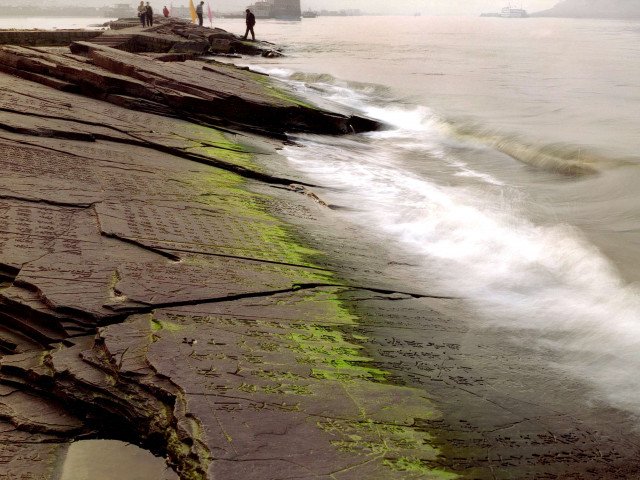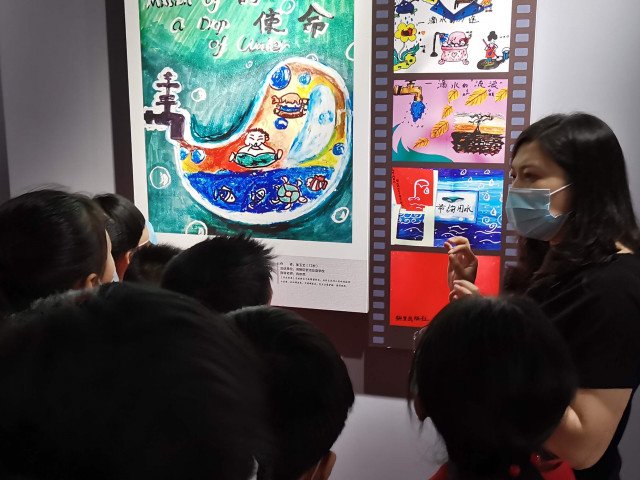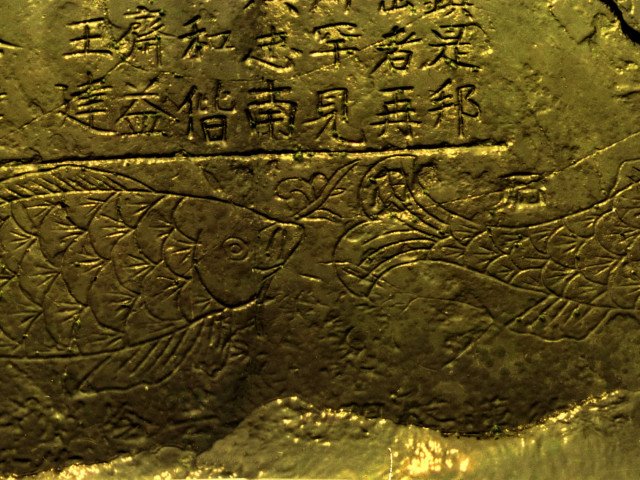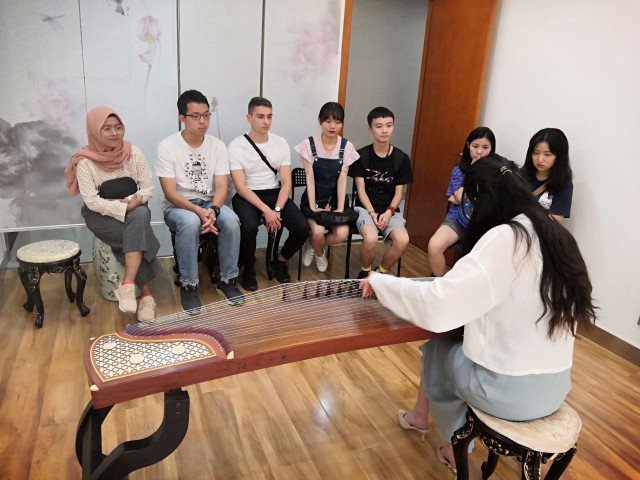Baiheliang Underwater Museum is located in Chongqing, China and is divided in three different parts: the exhibition hall, the corridors and the underwater inscriptions protection cover.
As for the underwater visiting, visitors would take a 91 m long escalator before they get to the river bottom which is 40 m under the Yangtze River, and then walk in the 146 m long underwater corridor to reach the underwater inscription protection cover. The inscription protection cover has a 70 m long visiting corridor, and 23 observation windows. Just from these glass windows, visitors can clearly view the cultural relic of the museum which is protected at its original site - Baiheliang Inscriptions.
Baiheliang Inscription was first engraved 1,200 years ago, about the year of Guangde of the Tang Dynasty (763 AD). Since then, there have been 165 inscriptions, 18 engraved fish, 2 Avalokiteshvara statues and 1 white crane. In 1988, Baiheliang was listed as a Key Cultural Relic Protection Unit, and in 2006, it was included in Chinese World Cultural Heritage Tentative List.
In terms of literature, art, and history, Baiheliang Inscriptions have significant values. Therefore, there exist not only exquisite engravings, calligraphy, poetry, but also philosophical reflection with profound implications.
To protect Baiheliang Inscriptions and preserve the precious historical memory, Chinese government adopted non-pressure container by Ge Xiurun, who is an academician of the Chinese Academy of Engineering and the professor of Shanghai Jiao Tong University, to build a museum. The construction of the museum commenced in 2003 and was finally completed in 2009, spending 7 years and a total cost of RMB 210,000,000. In 2010, UNESCO entitled it as the “The First Underwater Museum Accessible without Diving in the World”.
Temporary exhibitions
The Water We Want Exhibition 2020
In the frame of the Youth Prize Contest “The Water We Want 2020”, the Chongqing Baiheliang Underwater Museum organised a temporary exhibition with the students’ paintings telling the water they want. The Exhibition was held during the Chinese Farmer’s Harvest festival in Fuling, Chongqing.
Yangtze River Shipping · Yangtze River Boats
The Yangtze River originates in the Tanggula’s Main Peak -Geladandong Mountains on Tibetan Plateau, flows through three steps, is injected into the East China Sea from west to east, and is known as the nation's "Mother River". From the primitive rafts and boats in the prehistoric era to the high-tech large ships nowadays, the boats and ships traveling on the river, with a long history, have experienced a long evolution for thousands of years. Whether the small rafts in the ancient times or the large ships nowadays, they all have a common feature that they are the largest movable architecture on water constructed by human beings.
Ecological Yangtze River · Yangtze River Fish
The Yangtze River, the longest river in China and third longest river in the world, originates in Tibetan Plateau, with its main stream flowing through nine provincial areas and numerous tributaries entering it. The hydrology and landforms of the Yangtze River at the upper, middle and lower reaches vary a lot, and the natural environments also differ, so the fish fauna composition in it is complicated, and the fishery resources are quite abundant. As is recorded, there are about 300 kinds of fish in the river, about 1/3 of China’s freshwater fish. The exhibition mainly describes the rare fish and common fish in the Yangtze River Basin.
Itinerant Exhibition
Baiheliang Underwater Museum has always been devoted to spreading the water culture, and adopted the form of movable museum to deliver the pictures of the cultural relic and the introduction of the cultural relic to schools, villages, factories, and neighbourhoods. So far, it has performed more than 150 itinerant exhibitions with more than 210,000 audience. Human’s historical memories of 1200 years have been awakened, ancestors’ close relationship with water have been re-considered, and their awareness of respecting water, loving water, protecting water and living in harmony with water has been improved.
Chinese Ritual and Music
A Special Exhibition of Shang and Zhou Bronze Ware from the Middle Reaches of the Changjiang River at UNESCO Headquarters, June 2020.
Following the 2018 Great Rivers Forum, UNESCO Beijing Office and the Changjiang Civilization Museum have undertaken to produce a book titled “River Cultures: Life as a Dance to the Rhythm of Nature” (tentative), released on the occasion of the IHP Intergovernmental Council Session in June 2020. This book, by exploring positive examples on how humankind and rivers have been and are still living in harmony, would like to make this knowledge available for possible transfer into modern river management schemes, inspiring more harmonious way to live with the river. This includes i.a. respecting its natural features and “ecosystem services”, adapting human life forms (cultures) to the hydrological patterns (e.g. fishing, drawdown agriculture, river work considering a natural hydrological pattern), also including the psychological-spiritual linkage to the river (e.g. worshipping, well-being, detention, and environmental education, inspiration).
About the Exhibition:
The Changjiang Civilization Museum and the Hubei Provincial Museum have joined their forces to set this exhibition on “Chinese Ritual and Music — A Special Exhibition of Shang and Zhou Bronze Ware in the Middle Reaches of the Changjiang River”, which was already in display in Russia from March 3, 2014 to April 10, 2014, and have attracted more than 200,000 visitors.
With a selection of 103 pieces/sets of relic ware unearthed from the Jianghan region, the exhibition is intended to show the characteristics of Chinese civilization from the perspective of the bronze culture and is divided into three main parts:
- Part I: Bronzes of the Shang Dynasty (1600-1046 B.C.E.);
- Part II: Bronzes of the Western Zhou Dynasty (1046-771 B.C.E.);
- Part III: Bronzes of the Eastern Zhou Dynasty (770-256 B.C.E.).
The bronze culture of the State of Chu not only adopted the prevailing style of the Central Plain, but also integrated the designs of barbarian tribes. In addition to the State of Chu, the Wuhan region was occupied by other States, distinguished by their own unique cultures. The discovery of the Marquis Yi of Zeng's bronzes in 1978, especially the set of chime-bells, extolled the peak and miracle of the bronze culture in Eastern Zhou.
On the other hand, and more importantly, most of the exhibits were unearthed from Panlongcheng Relic Site. Panlongcheng Relic Site, which could be dated back to 3800 years ago, was recognized as the source of the Chinese culture in the south, and the root of Wuhan City. The Site is located to the north of the Changjiang River, and is 5 kilometers away from the downtown of Wuhan, capital of Hubei Province. The archaeological discovery in 1954 of Panlongcheng Relic Site in Wuhan underscored the southward expansion of the Zhou Dynasty, attesting to the cultural exchanges between the Yellow River Basin and the Changjiang River Basin. This discovery changed the perception that the Zhou culture did not extend beyond the Changjiang River. East and north sides of Panlongcheng Relic Site are near Panlong Lake, and its south side is close to the Fuhe River, leaving only its west side connects to the land.
The rise and fall of the city were closely linked to the river/water. The ancient city of Panlongcheng created brilliance in its history, and has made new achievements as a city of culture in its modern times. With 3000 years history, Panlongcheng Relic Site has become a superb window for people today to understand the Changjiang Civilization and even the Chinese Civilization.































